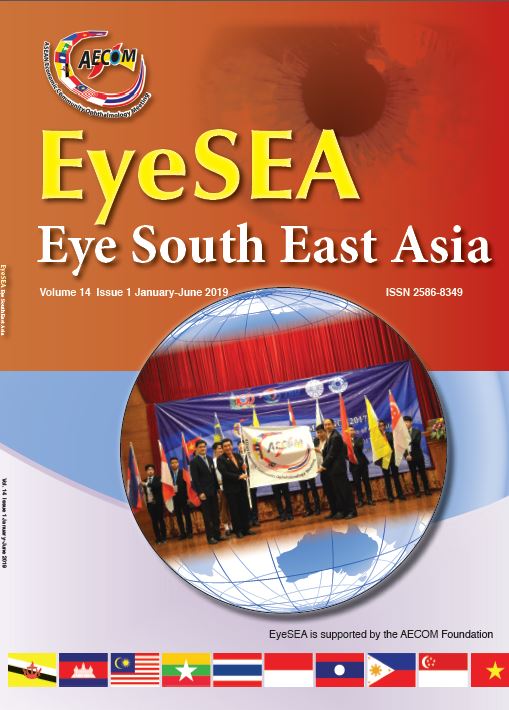A rare case of ocular toxoplasmosis complicated by both retinal detachment and choroidal neovascularization in an immunocompetent patient
Main Article Content
Abstract
Background: To report an unusual case of ocular toxoplasmosis complicated by both
retinal detachment and choroidal neovascularization in the same eye of an immunocompetent patient
Results: A 74-year-old gentleman of oriental origin presented with a 3-month history of reduced vision in the left eye: best corrected visual acuity was 6/6 in the right eye and 6/24 in the left eye. Clinical examination revealed no signs of systemic illness. The anterior segment in the left eye showed pigmented granulomatous keratic precipitates. Anterior chamber was deep with 3+ cells; no hypopyon. Both eyes were pseudophakic with clear media. Posterior segment of the left eye showed dense vitritis, with 2 areas of retinitis. No retinal breaks were visible. Serum Toxoplasmosis antibodies IgM was negative, but IgG was positive at 3.584. Vitreous tap was negative for CMV, HSV1, HSV2, and VZV DNA. Vitreous PCR for toxoplasmosis was not available at the time. He was started on oral Prednisolone 1 mg/kg, oral Bactrim (Sulfamethoxazole and Trimethoprim), and topical prednisolone acetate 1% (PredForte) 4-hourly. Visual acuity in the affected eye was 6/9 at 8 weeks post initiation of treatment. He subsequently developed retinal detachment which was operated with a visual outcome of 6/18. Unfortunately, he then developed choroidal neovascularization, and despite anti-VEGF treatment, did not regain his vision.
Conclusion: Prompt diagnosis of atypical presentation of ocular toxoplasmosis may aid management and subsequent preservation of visual function.
Conflicts of interest: The authors report no conflicts of interest.
Article Details
References
2.Kongyai N, Pathanapitoon K, Sirirungsi W, Kunavisarut P. Infectious causes of posterior uveitis and panuveitis in Thailand. Japanese Journal of Ophthalmology. 2012;56(4):390-5
3.Soheilian M, Heidari K, Yazdani S, et al. Patterns of uveitis in a tertiary eye care center in Iran. Ocul Immunol Inflamm
2004;12(4):297-310.
4.Pleyer U, Schlüter D, Mänz M. Ocular Toxoplasmosis: Recent Aspects of Pathophysiology and Clinical Implications.
Ophthalmic Res. 2014;52:116-23.
5.Holland GN. Ocular toxoplasmosis: A global reassessment. Part I: Epidemiology and course of disease. Am J Ophthalmol 2003;136:973-88.
6.Smith JR, Cunningham ET Jr. Atypical presentations of ocular toxoplasmosis. Curr Opin Ophthalmol. 2002;13(6):387-92
7.Fardeau C, Romand S, Rao NA, Cassoux N, Bettembourg O, Thulliez P, et al. Diagnosis of toxoplasmic retinochoroiditis with atypical clinical features. Am J Ophthalmol 2002;134:196–203
8.Bosch-Driessen LEH, Berendschot TTJM, Ongkosuwito JV, Rothova A. Ocular toxoplasmosis: Clinical features and
prognosis of 154 patients. Ophthalmology 2002;109:869-78.
9.Moshfeghi DM, Dodds EM, Couto CA, Santos CI, Nicholson DH, Lowder CY, et al. Diagnostic Approaches to Severe, Atypical Toxoplasmosis Mimicking Acute RetinalNecrosis. Ophthalmology 2004;111:716–25
10.Cutler N. December 2014 Wills Eye Resident Case Series - Diagnosis & Discussion. The recent return of earlier floaters and decreased vision in one eye mark the latest signs in a patient with previous vitreous detachment. Review of Ophthalmology. 2014
11.Kim SJ, Scott IU, Brown GC, Brown MM, Ho AC, Ip MS, et al. Interventions for toxoplasma retinochoroiditis: a report
by the American Academy of Ophthalmology. Ophthalmology. 2013;120(2):371-8
12.Felix JP, Lira RP, Zacchia RS, Toribio JM, Nascimento MA, Arieta CE. Trimethoprim-sulfamethoxazole versus placebo to reduce the risk of recurrences of Toxoplasma gondii retinochoroiditis: randomized controlled clinical trial. Am J Ophthalmol. 2014;157(4):762- 6.
13.Stanford MR, See SE, Jones LV, Gilbert RE. Antibiotics for toxoplasmic retinochoroiditis: An evidence-based systematic review. Ophthalmology. 2003;110:926-31
14.Jasper S, Vedula SS, John SS, Horo S, Sepah YJ, Nguyen QD. Corticosteroids as adjuvant therapy for ocular toxoplasmosis. Cochrane Database Syst Rev. 2013;(4):CD007417
15.Oray M, Ozdal PC, Cebeci Z, Kir N, Tugal-Tutkun I. Fulminant ocular toxoplasmosis: the hazards of corticosteroid
monotherapy. Ocul Immunol Inflamm. 2015;8:1-10.
16.Faridi A, Yeh S, Suhler E, Smith J, Flaxel CJ. Retinal detachment associated with ocular toxoplasmosis. Retina. 2015;35:358-63.
17.Bosch-Driessen LH, Karimi S, Stilma JS, Rothova A. Retinal detachment in ocular toxoplasmosis.Ophthalmology. 2000; 107: 36-40.
18.Fine SL, Owens SL, Haller JA, Knox DL, Patz A. Choroidal Neovascularization as a Late Complication of Ocular Toxoplasmosis.Am J Ophthalmol. 1981;91:318-322.
19.Spilsbury K, Garrett KL, Shen WY, Constable IJ, Rakoczy PE. Overexpression of Vascular Endothelial Growth Factor
(VEGF) in the retinal pigment epithelium leads to the development of choiroidal neovascularization. Am J Pathology. 2000;157:135-44.
20.Rasier R, Gormus U, Artunay O, Yuzbasioglu E, Oncel M, Bahcecioglu H. Vitreous levels of VEGF, IL-8, and TNF-alpha in retinal detachment. Current Eye Research. 2010;35:505-9.
21.Benevento JD, Jager RD, Noble G, Latkany P, Mieler WF, Sautter M, et al. Toxoplasmosis-Associated neovascular lesions treated successfully with ranibizumab and antiparasitic therapy. Arch Ophthalmol. 2008;126:1152-6.
22.Korol AR, Zborovska O, Kustryn T, Dorokhova O, Pasyechniko N. Intravitreal aflibercept for choroidal neovascularization associated with chorioretinitis: a pilot study. Clin Ophthalmol. 2017;11:1315–20.
23.Mauget-Faysse M, Mimoun G, Ruiz-Moreno J, Postelmans L, Soubrane G, Defauchy M, et al. Verteporfin photodynamic therapy for choroidal neovascularization associated with toxoplasmic retinochoroiditis. Retina. 2006;26:396-403.
24.Adán A, Mateo C, Wolley-Dod C. Surgery for subfoveal choroidal neovascularization in toxoplasmic retinochoroiditis.
Am J Ophthalmol. 2003;135:386-7.


